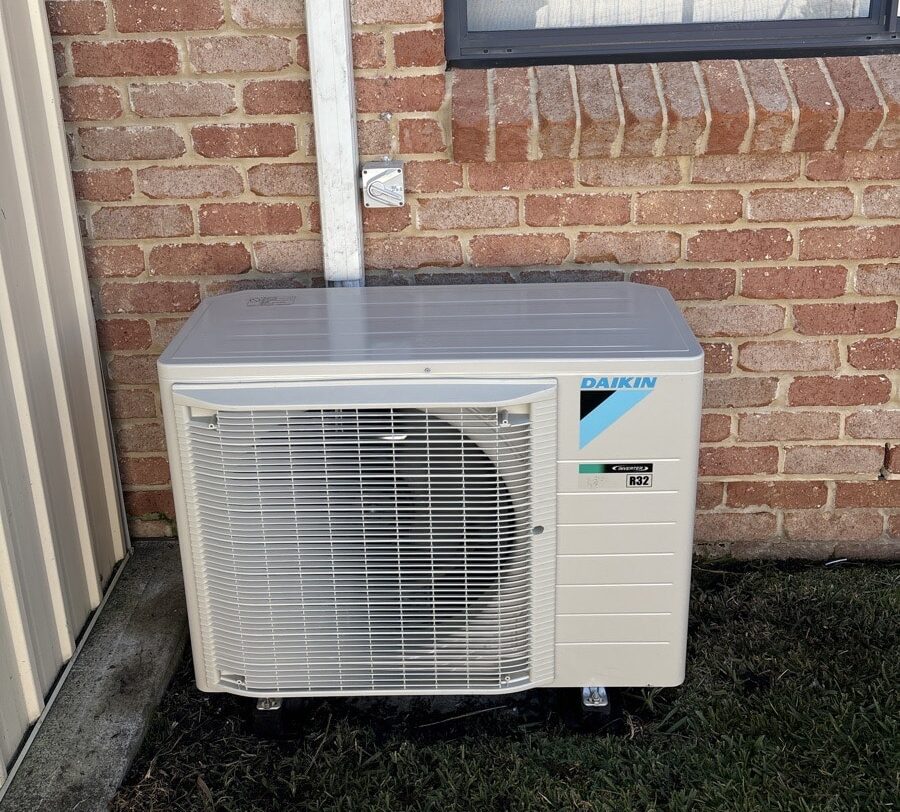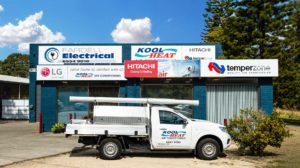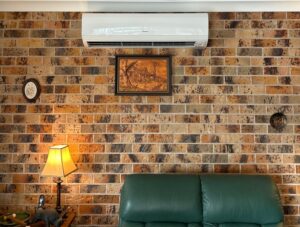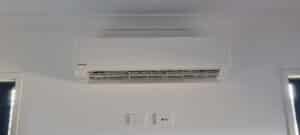Choosing the best AC for your home in Forster involves considering several key factors. First, we need to assess our cooling needs by analysing the local climate and our home’s layout. It’s essential to evaluate different AC types and brand features, balancing initial costs against long-term maintenance. Energy efficiency is crucial, so let’s prioritize models with high Energy Star and SEER ratings. Proper sizing and professional installation ensure optimal performance while budgeting for costs like installation and maintenance help avoid surprises.
Considering local humidity and temperature fluctuations will lead us to the ideal choice. Our comprehensive guide offers more to explore.
Key Takeaways
– Conduct a climate analysis to determine the necessary AC capacity and features for Forster’s warm, humid summers.
– Compare AC types for energy efficiency, noise levels, and innovative cooling technologies suitable for your home layout.
– Choose units with high Energy Star and SEER ratings to ensure significant energy savings and environmental benefits.
– Consult professionals to size your AC correctly based on room dimensions, ceiling height, and insulation quality.
– Consider humidity control features to improve comfort and reduce mould growth in Forster’s humid climate.
Understanding Your Cooling Needs
Before choosing an AC unit, we must assess our home’s specific cooling requirements to ensure maximum comfort and efficiency.
First, let’s conduct a climate analysis. Living in Forster, we know the climate can be warm and humid, especially during summer months. Understanding the local climate helps us determine the capacity and features our AC unit should have. We’ll want a system that can handle high temperatures and humidity levels, ensuring it performs efficiently even on the hottest days.
Next, we need to consider the room layout. Each room in our home may have different cooling needs based on its size, ceiling height, and exposure to sunlight. For instance, rooms with large, south-facing windows may require a more powerful unit or additional cooling solutions, like fans or shades, to maintain comfort.
We should also think about how airflow moves throughout our home. Open floor plans might allow for easier distribution of cool air, whereas closed-off spaces could need individual units for effective cooling.
Comparing AC Types
When comparing AC types, we must evaluate the characteristics of each system to determine which best fits our home’s cooling needs and energy efficiency goals. First, let’s look at the brand comparison. Different brands offer various features and technologies; some might prioritize innovative cooling mechanisms, while others focus on reliability and longevity. By analyzing brands, we can narrow down options that align with our expectations.
Next, we conduct a cost analysis. Initial purchase price is a key factor, but we should also consider installation costs and long-term maintenance expenses. Cheaper units might incur higher operational costs in the future, whereas investing in a premium brand could save us money over time.
Noise level is another important consideration. Some AC types operate quietly, making them suitable for bedrooms and living rooms, while others might be louder, which could be distracting in noise-sensitive areas. Ensuring we select a system with an acceptable noise level enhances comfort.
Importance of Energy Efficiency
As we choose the right AC for our home, prioritizing energy efficiency not only helps reduce utility bills but also supports environmental sustainability. By focusing on energy savings, we can lessen the environmental impact of our cooling systems. An energy-efficient AC consumes less electricity while maintaining optimal performance, making it a smart choice for both our wallets and the planet.
To ensure we select an energy-efficient model, let’s consider the following:
1. Energy Star Rating: Look for units with a high Energy Star rating. These models meet stringent guidelines for energy efficiency, ensuring significant energy savings over time.
2. Seasonal Energy Efficiency Ratio (SEER): The higher the SEER rating, the more energy-efficient the AC. A higher SEER means the unit uses less energy to cool our home, reducing electricity costs.
3. Inverter Technology: ACs with inverter technology adjust their power usage according to the room’s temperature, ensuring efficient operation and minimal energy wastage.
4. Smart Thermostats: Integrating a smart thermostat with our AC allows us to automate and optimize cooling schedules, enhancing energy efficiency and contributing to further energy savings.
Sizing Your Air Conditioner
Choosing the right size air conditioner is crucial for achieving optimal cooling efficiency and comfort in our home. We need a unit that’s neither too large nor too small. An oversized air conditioner will cycle on and off too frequently, leading to inefficient energy use and unnecessary wear.
On the other hand, a unit that’s too small won’t cool our space effectively, especially during those warm Forster summers.
To determine the right size, we should consider the room’s square footage, ceiling height, and insulation quality. Consulting with a professional can provide us with precise calculations, ensuring our AC is the perfect fit.
Proper installation plays a vital role too. Even the best-sized unit won’t perform well if it’s not installed correctly. We should ensure the installer follows all guidelines for setting up the system to maximize efficiency and longevity.
Once our air conditioner is up and running, adhering to a maintenance schedule is essential. Regular servicing keeps the unit in top shape, prevents unexpected breakdowns, and extends its lifespan. By doing this, we maintain a comfortable environment in our home without compromising on energy efficiency.
Budget Considerations
While ensuring our air conditioner fits our home’s needs, we must also consider how it aligns with our budget. It’s crucial to strike a balance between cost and performance. First, we need to compare brand options. Different brands offer varied levels of efficiency and durability, impacting both initial and long-term costs. Choosing a brand that provides the best value for money is essential.
Next, we should evaluate the cooling capacity required for our space. A unit that’s too powerful or too weak will lead to inefficient energy use and higher bills. Determining the right capacity ensures optimal performance and cost-effectiveness.
Here’s how we can approach our budget considerations:
1. Research Brand Options: Compare prices and features across multiple brands to find the most reliable and cost-effective option.
2. Assess Cooling Capacity Needs: Choose a unit based on the size of our space to avoid overspending on unnecessary power.
3. Check Warranty Coverage: A good warranty can save us money on repairs and maintenance over time.
4. Consider Installation Costs: Budget for installation expenses, as these can significantly impact the total cost of owning an AC.
Evaluating Installation Requirements
Let’s dive into what we need to know about the installation requirements for our new AC unit. First, we should conduct a thorough location analysis. We need to determine where the AC will be most effective, considering factors such as sunlight exposure and airflow. Space constraints play a crucial role here. If our chosen spot is too cramped, it could hinder the AC’s performance and efficiency. We must ensure there’s ample space for the unit to operate optimally.
Next, assessing electrical compatibility is essential. Our home’s wiring must support the AC’s power needs without overloading the system. We should check the amperage and voltage requirements of the unit and match them with our current electrical setup. If necessary, consulting with an electrician can help us make needed adjustments safely.
Lastly, let’s not forget to perform a ductwork evaluation if we’re opting for a central air system. We need to ensure that our existing ducts can accommodate the new unit, allowing for efficient distribution of cool air throughout our home. This step helps prevent any loss of efficiency and ensures our home stays comfortably cool.
Maintaining Your AC System
Keeping our AC system in top condition requires regular maintenance to ensure efficient performance and longevity. By staying proactive, we can avoid unexpected breakdowns and keep our homes cool and comfortable. One of the simplest yet most effective tasks is regular maintenance, which includes routine inspections and cleanings.
Let’s dive into some key steps for maintaining our AC system:
1. Filter Replacement: We should replace or clean the air filters every 1-3 months, especially during peak usage. A clean filter improves airflow and efficiency, reducing energy consumption.
2. Check Thermostat Settings: Ensuring our thermostat is functioning correctly helps maintain the desired temperature without overworking the system. It’s a good idea to consider upgrading to a programmable thermostat for more precise control.
3. Inspect and Clean Coils: Over time, the evaporator and condenser coils collect dirt, which impairs airflow. By cleaning these coils annually, we ensure the AC operates efficiently.
4. Clear Debris: Outdoor units can accumulate leaves, dirt, and debris. By keeping the area around the unit clear, we improve airflow and prevent potential damage.
Local Climate Considerations
As we maintain our AC system, we must also consider Forster’s unique climate to ensure optimal performance and comfort in our home. Forster experiences warm, humid summers and mild winters, which means our AC units need to handle both humidity control and temperature regulation efficiently. Proper insulation tips and weatherproofing techniques can significantly impact how effectively our AC operates. By sealing gaps in doors and windows and ensuring our home is well-insulated, we reduce the workload on our AC, maintaining a consistent indoor climate.
Humidity control is particularly crucial in Forster, where high moisture levels can lead to discomfort and potential health issues. We should look for AC units with built-in dehumidifiers or the capability to adjust humidity settings. This feature helps remove excess moisture from the air, improving comfort and reducing mould growth.
Temperature regulation is another key factor. An AC system that adjusts to the fluctuating temperatures of Forster’s climate will provide better comfort and energy efficiency. Programmable thermostats can help us maintain optimal temperatures throughout the day, adapting to our schedule and the local weather conditions.
Frequently Asked Questions
What Are the Latest Smart Features Available in Modern AC Units?
Let’s dive into the latest smart features in modern AC units. They boast impressive energy efficiency and allow us to control them remotely via smartphone apps.
We can use voice command features for hands-free operation. These units also offer programmable settings, letting us customize cooling schedules to fit our daily routines.
With such advancements, we can maintain comfort while maximizing convenience and reducing energy consumption.
How Does AC Noise Level Impact Home Comfort?
When we consider the impact of AC noise levels on home comfort, it’s clear that noise pollution affects our peace significantly.
Employing noise reduction techniques or soundproofing solutions can enhance our environment, improving sleep quality and overall comfort.
We often overlook how constant hums can disrupt relaxation, but by prioritizing quieter units, we ensure our home remains a sanctuary, free from unnecessary disturbances and fostering a restful atmosphere.
Are There Any Eco-Friendly Refrigerant Options for AC Units?
Let’s explore eco-friendly refrigerant options for AC units.
We can choose refrigerants like R-32 or R-410A, which offer improved energy efficiency and cost savings.
These options reduce the environmental impact and promote sustainability.
By making this choice, we’re not only cutting down on our energy bills but also supporting a healthier planet.
We must prioritize sustainable solutions for our homes and future generations.
How Can I Improve Indoor Air Quality With My AC System?
To improve indoor air quality with our AC system, let’s focus on air purifiers and ventilation.
We can enhance air circulation by ensuring our system provides adequate ventilation.
Regular filter maintenance is crucial, so we’ll replace or clean filters to keep air fresh.
Managing humidity control helps too, preventing mold growth.
What Are the Top AC Brands Recommended for Durability and Performance?
When we look for top AC brands for durability and performance, we often find that brands like Daikin, Mitsubishi, and Panasonic stand out. They offer excellent energy efficiency and comprehensive warranty options, ensuring peace of mind.
Installation costs vary, but these brands often provide reliable service. Maintenance requirements are minimal, which keeps long-term costs down. Choosing these brands means we’re investing in quality and efficiency for our home comfort.
Conclusion
In choosing the best AC for our home in Forster, we must consider several factors. Let’s start by understanding our cooling needs and comparing various AC types.
Energy efficiency is crucial, so we should always check for high-efficiency models. Proper sizing ensures optimal performance, while budget considerations keep us on track financially.
We can’t overlook installation requirements and ongoing maintenance. Lastly, the local climate impacts our choice, so let’s choose wisely to stay comfortable year-round.



